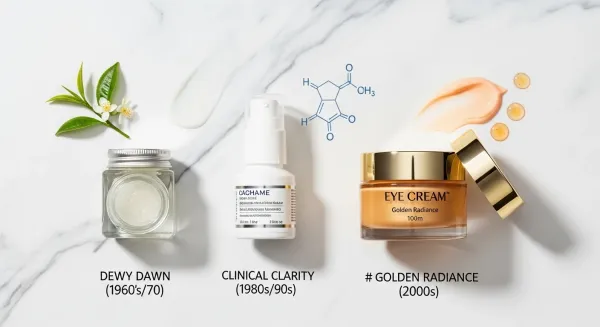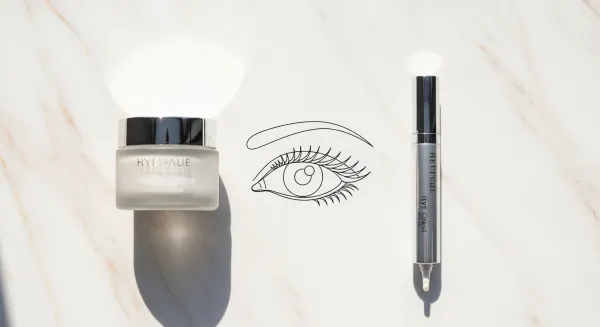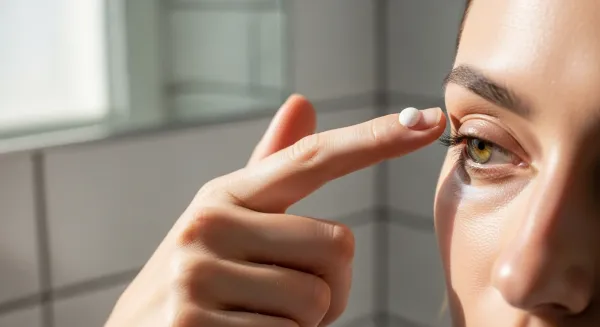Essential Skincare Routine for Redness and Rosacea: Tips for Soothing Sensitive Skin
Discover tips for a soothing skincare routine to manage redness and rosacea effectively.

If you struggle with redness and rosacea, you know how challenging it can be to find the right skincare routine.
This guide will help you understand rosacea, identify triggers, and create a soothing regimen tailored for sensitive skin.
With the right approach, you can manage your symptoms effectively and feel more comfortable in your own skin.
Key Takeaways
- Rosacea is a common skin condition that causes redness and sensitivity.
- Identifying triggers like stress and certain foods can help reduce flare-ups.
- Use gentle cleansers and avoid scrubbing to protect sensitive skin.
- Moisturizing daily with the right ingredients is crucial for skin health.
- Always apply sunscreen to protect against UV rays that can worsen rosacea.
Understanding Rosacea and Redness

What is Rosacea?
Rosacea is a common skin condition that makes our face look red and flushed. It can feel a bit embarrassing, but we're not alone—many people deal with it!
This condition often shows up as redness on the cheeks, nose, and forehead. It can also cause tiny bumps that look like acne.
Common Symptoms of Rosacea
When we think about rosacea, we should keep an eye out for these symptoms:
- Redness on the face
- Sensitive or burning skin
- Flushing or blushing easily
- Visible blood vessels
- Dry patches on the nose and cheeks
How Redness Manifests in Rosacea
The redness we see can vary from person to person. For some, it might be a light blush, while for others, it can be a deep, persistent red. This redness can be triggered by different factors, like stress, heat, or certain foods.
Managing rosacea can be tricky, but a gentle skincare routine is crucial for those with rosacea because it helps to minimize irritation, protect the skin barrier, prevent dryness, and reduce redness.
Understanding rosacea is the first step in finding ways to soothe our sensitive skin. By knowing what it is and how it affects us, we can better manage our skincare routine and feel more comfortable in our own skin!
Identifying Triggers for Rosacea Flare-Ups

Common Triggers to Avoid
When it comes to rosacea, knowing what sets off our flare-ups is super important. Some common triggers include:
- Hot drinks like coffee or tea
- Spicy foods
- Stress
- Extreme temperatures (both hot and cold)
- Alcohol
- Sunlight
How to Track Your Triggers
Tracking our triggers can help us manage rosacea better. Here’s how we can do it:
- Keep a diary: Write down what you eat, drink, and any activities you do.
- Note your symptoms: Record when you notice flare-ups and what you think caused them.
- Look for patterns: After a few weeks, see if you can spot any common triggers.
Managing Stress and Its Impact on Rosacea
Stress can really mess with our skin. To help manage it, we can:
- Practice relaxation techniques like deep breathing or yoga.
- Make time for hobbies that we enjoy.
- Get enough sleep to help our bodies recover.
Remember, avoiding triggers is a great start, but it might not be the only solution. If we find that our rosacea is still acting up, it might be time to consult a dermatologist for more tailored advice!
Gentle Cleansing for Sensitive Skin
When it comes to caring for our skin, especially if we have rosacea, gentle cleansing is key. We want to keep our skin calm and happy! Here are some tips to help us choose the right cleanser and cleanse effectively:
Choosing the Right Cleanser
- Look for a gentle formula: Cleansers labeled as suitable for sensitive skin are our best friends. Brands like Cetaphil or CeraVe are great options.
- Check for niacinamide: This ingredient can help reduce inflammation and protect our skin from stressors.
- Consider synthetic ingredients: Sometimes, cleansers made with synthetic detergents can be less irritating than traditional soaps.
How Often Should You Cleanse?
- We should aim to cleanse our face twice a day—once in the morning and once before bed. This helps remove dirt and oil that can irritate our skin.
- If our skin feels extra sensitive, we might want to adjust how often we cleanse. Listening to our skin is important!
Cleansing Techniques for Rosacea-Prone Skin
- Use lukewarm water: Hot water can make redness worse, so lukewarm is the way to go.
- Apply gently: Use our fingertips to apply the cleanser in a circular motion. No scrubbing!
- Rinse thoroughly: Make sure to rinse off all the cleanser to avoid irritation.
- Pat dry: Use a clean, soft towel to gently pat our face dry.
Remember, cleansing is just one part of our skincare routine. Following up with a good moisturizer is essential to keep our skin hydrated and protected!
Moisturizing to Repair and Protect
When it comes to caring for our skin, especially if we’re dealing with rosacea, moisturizing is key. A good moisturizer can make a world of difference! It helps to lock in hydration and protect our skin from irritants. Here’s what we need to know:
Importance of Hydration
- Hydration keeps our skin barrier strong.
- It helps reduce redness and irritation.
- Well-hydrated skin looks healthier and feels better.
Best Ingredients for Rosacea-Friendly Moisturizers
We should look for moisturizers that contain:
- Ceramides: They help restore the skin barrier.
- Hyaluronic Acid: This ingredient draws moisture into the skin.
- Glycerin: It’s a great humectant that keeps our skin hydrated.
How to Apply Moisturizer Effectively
- Cleanse: Always start with a gentle cleanser.
- Pat Dry: Gently pat your skin dry with a soft towel.
- Apply: Use a small amount of moisturizer and spread it evenly.
- Massage: Lightly massage it into the skin for better absorption.
Remember, moisturizing is not just about comfort; it’s about protecting our skin from further irritation and damage.
By keeping our skin hydrated, we can help manage redness and keep our skin looking its best!
Sun Protection is a Must

When it comes to taking care of our skin, sun protection is super important, especially for those of us dealing with rosacea. UV rays can really trigger flare-ups and make our skin feel even more irritated.
So, let’s dive into why we need to be extra careful and how we can do it right!
Why SPF is Crucial for Rosacea
We all know that the sun can be harsh, but for those of us with rosacea, it can be a major culprit behind flare-ups.
Here’s why we should never skip sunscreen:
- Prevents inflammation: Sunscreen helps keep our skin calm and reduces the chances of redness.
- Protects against skin damage: Regular use can help prevent long-term damage from UV rays.
- Keeps our skin barrier strong: A good SPF can help maintain our skin’s natural defenses.
Choosing the Right Sunscreen
Not all sunscreens are created equal! Here are some tips to find the best one for our sensitive skin:
- Look for SPF 30 or higher: This is the minimum we should aim for to keep our skin protected.
- Opt for mineral formulas: Sunscreens with zinc oxide or titanium dioxide are usually gentler on our skin.
- Avoid fragrances: Fragrance-free options are less likely to irritate our skin.
Sunscreen Type | SPF Level | Key Ingredients |
|---|---|---|
Mineral Sunscreen | 30+ | Zinc Oxide, Titanium Dioxide |
Chemical Sunscreen | 30+ | Avobenzone, Octisalate |
How to Apply and Reapply Sunscreen
Applying sunscreen correctly is just as important as choosing the right one. Here’s how we can do it:
- Apply generously: Use about a shot glass full for our entire body.
- Reapply every two hours: Especially if we’re sweating or swimming.
- Don’t forget the areas: Make sure to cover our ears, neck, and any exposed skin.
Remember, even on cloudy days, UV rays can still reach our skin. So, let’s make it a habit to wear sunscreen every day!
By following these tips, we can help keep our skin protected and reduce the chances of rosacea flare-ups. Let’s embrace the sun safely!
Makeup Tips for Rosacea-Prone Skin
When it comes to makeup for sensitive and rosacea-prone skin, we all want to look our best without causing irritation. Here are some tips to keep in mind:
Choosing Rosacea-Friendly Makeup
- Opt for water-based or powder formulas: These are less likely to irritate your skin.
- Use yellow or green-tinted concealers: Yellow can help mask discoloration, while green is great for camouflaging redness.
- Avoid heavy foundations: Instead, go for lightweight options that let your skin breathe.
Application Tips to Avoid Irritation
- Start with a clean face: Always cleanse gently before applying makeup.
- Use clean brushes and sponges: This helps prevent bacteria from irritating your skin.
- Apply in thin layers: Less is more! Build up coverage gradually to avoid a cakey look.
Removing Makeup Gently
- Use a gentle makeup remover: Look for products that are fragrance-free and designed for sensitive skin.
- Avoid scrubbing: Instead, gently wipe away makeup with a soft cloth or cotton pad.
- Follow up with a soothing cleanser: This helps remove any leftover makeup and calms your skin.
Remember, taking care of our skin is just as important as looking good. By following these tips, we can enjoy makeup without compromising our skin's health. Makeup can be fun, but our skin comes first!
When to Consult a Dermatologist

Signs You Need Professional Help
If we notice any persistent redness, flushing, or other symptoms that seem like rosacea, it’s time to reach out to a dermatologist. Getting a professional opinion can make a big difference! Here are some signs that we should consult a dermatologist:
- Symptoms that don’t improve with over-the-counter treatments
- New or worsening skin changes
- Uncertainty about whether it’s rosacea or something else
What to Expect During a Dermatology Visit
When we finally make that appointment, it’s good to know what to expect. Here’s a quick rundown:
- A thorough skin examination
- Discussion of our symptoms and medical history
- Possible tests to rule out other conditions
Treatment Options for Rosacea
After our visit, the dermatologist might suggest various treatment options. These can include:
- Topical medications
- Oral medications
- Lifestyle changes to manage triggers
Remember, consulting a dermatologist is key to getting the right treatment for our skin. They can help us find the best routine tailored just for us!
Wrapping It Up: Your Path to Calm Skin
So, there you have it!
Taking care of skin that gets red and irritated doesn’t have to be a hassle. By sticking to gentle products, keeping your routine simple, and knowing what triggers your flare-ups, you can help your skin feel a lot better.
Remember, it’s all about being kind to your skin. If you ever feel stuck, don’t hesitate to reach out to a dermatologist for advice.
Frequently Asked Questions About Rosacea
What is Rosacea?
Rosacea is a common skin condition that primarily affects the face. It is characterized by redness, flushing, visible blood vessels, and sometimes small, acne-like bumps. While the exact cause is unknown, various triggers can worsen symptoms. Dermatoses are skin conditions like eczema or psoriasis that wreck your barrier and confidence. The fix? Barrier creams, topical ceramides, and anti-inflammatory treatments. They tackle the root cause and keep your skin in the game. No frills, just results.
What are common rosacea triggers?
Common triggers include: Food and drink: Hot beverages, spicy foods, and alcohol, Environmental factors: Extreme temperatures (hot or cold), sunlight, and wind, Stress and emotional factors: Anxiety and emotional stress, Skincare products: Harsh ingredients and fragrances. Your lifestyle choices can make or break your skin barrier. Stress Management: Practice stress-reducing techniques like meditation or yoga. It's about taking a holistic approach to your health and well-being. Besides using the right moisturizer, several lifestyle factors can support barrier repair.
How can I identify my personal rosacea triggers?
Keep a detailed diary tracking your diet, activities, skincare products used, and any rosacea flare-ups. Over time, patterns may emerge, helping you pinpoint specific triggers to avoid. Because many beauty products contain preservatives, chemicals or fragrances that could irritate or dry out your skin, it's a good idea to introduce new products one at a time. If you have sensitive skin, Dr. Khetarpal recommends using a pea-sized dot of product behind your ear, along your jawline, and waiting a day or two to make sure your skin doesn't react before applying it to your whole face.
What is the best way to cleanse rosacea-prone skin?
Choose a gentle, fragrance-free cleanser formulated for sensitive skin. Avoid harsh scrubbing and use lukewarm water. Cleanse twice daily, or adjust frequency as needed based on your skin's sensitivity. Because regular bar soap often contains harsh ingredients that can be drying to the skin, wash your face with a mild facial cleanser and lukewarm — not hot — water. Avoid harsh cleansers and over-exfoliation. Gentle cleansers are ideal for daily use, especially for dry or sensitive skin, as they protect the skin's natural barrier.
What ingredients should I look for in a moisturizer for rosacea?
Look for moisturizers containing: Ceramides: Help restore the skin barrier and retain moisture, Hyaluronic Acid: Attracts and holds moisture, hydrating the skin, Glycerin: Another humectant that helps keep skin hydrated. Ceramides are like the mortar between the bricks (skin cells) of your skin barrier. They're essential lipids that help maintain the barrier's structure and prevent moisture loss. Hyaluronic acid (HA) is a humectant, meaning it attracts and holds onto water like a magnet. It can hold up to 1000 times its weight in water! This makes it a powerhouse for hydrating sensitive skin without clogging pores or causing irritation. What's the Difference Between Hydration and Moisturization, and Why Do I Need Both? Hydration is about increasing the water content of your skin, while moisturization is about preventing that water from escaping. Think of it like this: hydration is like filling a bucket with water, and moisturization is like putting a lid on it to keep the water from evaporating.
Why is sunscreen crucial for managing rosacea?
UV rays from the sun can trigger inflammation and worsen rosacea symptoms. Choose a broad-spectrum sunscreen with an SPF of 30 or higher, preferably a mineral formula with zinc oxide or titanium dioxide. Everyone should use sunscreen that offers broad-spectrum protection (protects against UVA and UVB rays), SPF 30 or higher, and water resistance. A sunscreen that offers the above helps to protect your skin from sunburn, early skin aging, and skin cancer. Sunscreen use can help prevent skin cancer by protecting you from the sun's harmful ultraviolet (UV) rays. Anyone can get skin cancer, regardless of age, gender, or skin tone. In fact, it is estimated that one in five Americans will develop skin cancer in their lifetime. Sunscreen can also help prevent premature skin aging, such as wrinkles and age spots, caused by too much unprotected UV exposure. UVA rays (or aging rays) can prematurely age your skin, causing wrinkles and age spots, and can pass through window glass. You should apply sunscreen every day on skin not covered by clothing if you will be outside. The sun emits harmful UV rays year-round. Even on cloudy days, up to 80% of the sun's harmful UV rays can penetrate the clouds.
Are there makeup tips for people with rosacea?
Opt for water-based or powder makeup formulas, as they are less likely to irritate. Use yellow or green-tinted concealers to neutralize redness and avoid heavy foundations that can clog pores. Always apply makeup with clean brushes and sponges. It's best to avoid makeup until your barrier is healed, as it can further irritate the skin. However, if you must wear makeup, choose non-comedogenic, fragrance-free products and ensure thorough but gentle cleansing afterward. Because many beauty products contain preservatives, chemicals or fragrances that could irritate or dry out your skin, it's a good idea to introduce new products one at a time.
When should I see a dermatologist for rosacea?
Consult a dermatologist if: Over-the-counter treatments don't improve symptoms, You experience new or worsening skin changes, You are unsure if your symptoms are caused by rosacea or another condition. For mild cases, you can repair a compromised barrier with gentle products and good habits. However, if you experience: Persistent skin sensitivity, Repeated skin infections, Chronic conditions like dermatitis, ...it's time to see a dermatologist. They can tailor treatments to your skin's needs. Dermatologists are essential for diagnosing and treating conditions related to a compromised skin barrier. Consulting a dermatologist ensures you're not just guessing about your skin's needs. If you're experiencing severe or persistent skin issues, it's best to consult a dermatologist for personalized advice and treatment. New spots or moles that itch, bleed, or change color are often early warning signs of skin cancer. If you notice any suspicious spots, make an appointment to see a dermatologist. Dermatologists are skin cancer experts.




